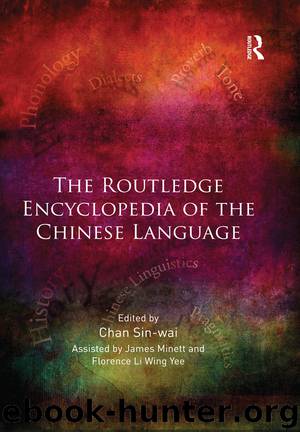The Routledge Encyclopedia of the Chinese Language by Unknown

Author:Unknown
Language: eng
Format: epub
ISBN: 9781317382478
Publisher: Taylor & Francis Ltd
Published: 2016-04-19T16:00:00+00:00
21
Chinese Taboo
Amy He Yun
UNIVERSITY OF HUDDERSFIELD, UNITED KINGDOM
入竟(境)而问禁,入国而问俗,入门而问讳(《礼记》 )
Ask about the prohibition upon entering a land,
the customs upon entering a country, and
the names to be avoided upon entering a home.
(Liji or Book of Rites)
Introduction
Why are chopsticks called kuài in Chinese? Why do etiquette books advise us not to give clocks as presents in China? And why are tourism promotional slogans such as Wǒ-kào-Chóngqìnɡ and Yī-zuò-jiào-chūn-de-chéngshì criticized for transgressing common decency? The key to answering these questions lies in the notion of taboo and related concepts such as euphemism. In principle, anything can be taboo, including persons (e.g. pregnant women), acts (e.g. incest) and things (e.g. blood), for example. This chapter, nevertheless, aims to provide an introduction to Chinese taboo, past and present, including taboo words and expressions, euphemisms, motivations, functions and means to avoid punishments and sanctions for taboo violations. In what follows, I first contextualize this article by delineating the key concepts, historicizing the milestones of Chinese taboo development and reviewing very briefly relevant literature, in a somewhat streamlined and simplified form. Then, after outlining the structure of this chapter, I proceed to present Chinese taboo in detail.
Central to this chapter is the concept of taboo, which is the prohibition or restriction of an action based on the belief that such behavior is too sacred and consecrated, obscene and dirty, dangerous, accursed and unlucky or immoral for ordinary individuals to undertake. Linguistic taboo is accordingly defined as the total or partial prohibition or restriction of the use of certain words, expressions and topics on the basis of the aforementioned belief. Another core term is euphemism, referring to circumlocutionary usage of language in which an inoffensive or pleasant term is substituted for another that is thought to be coarse, painful, unpleasant, derogatory or unlucky (Hughes 2006; Rawson 1981). Euphemisms are in a constant state of flux: Some die away soon after being created while others last for centuries and develop into unconscious ones. Like taboos, they are variously motivated, for example, by fear, kindness, good taste, politeness, and political correction or commercial ‘deception’. Then, to mention in passing, the opposite of euphemism is dysphemism, which, by and large, is tabooed. These definitions allow me to sketch the prominent stages of Chinese taboo development and to give a suggestive overview of the literature.
Taboo is such an extremely ancient phenomenon in China that words tabooed at a certain point in history total 987 (Y. Wang 1997). Nonetheless, there is broad agreement that most basic ideas about it were shaped in the Zhou dynasty that ruled ancient China for almost a millennium (Chen 1997[1928]). Among other historical texts, taboo is discussed most insightfully in the Wujing, ‘five classics’, the main part of Confucian canon, for example, in the highly quoted passage from the Liji provided at the outset of this chapter. This is partly attributable to Confucius’s effort to zhèngmíng, ‘rectify names’, ultimately to restore the social hierarchy of the Zhou. In the Qin–Han empires, the hierarchical nature of taboo, particularly name taboos
Download
This site does not store any files on its server. We only index and link to content provided by other sites. Please contact the content providers to delete copyright contents if any and email us, we'll remove relevant links or contents immediately.
Weapons of Math Destruction by Cathy O'Neil(5829)
Cracking the GRE Premium Edition with 6 Practice Tests, 2015 (Graduate School Test Preparation) by Princeton Review(4041)
What It Really Takes to Get Into Ivy League and Other Highly Selective Colleges by Hughes Chuck(3551)
Fooled by Randomness: The Hidden Role of Chance in Life and in the Markets by Nassim Nicholas Taleb(2860)
The Tyranny of Metrics by Jerry Z. Muller(2846)
The Marketing Plan Handbook: Develop Big-Picture Marketing Plans for Pennies on the Dollar by Robert W. Bly(2792)
Ultralearning by Scott Young(2730)
The Official Guide for GMAT Review 2015 with Online Question Bank and Exclusive Video by Graduate Management Admission Council (GMAC)(2643)
50 Economics Classics by Tom Butler-Bowdon(2409)
The Visual MBA by Jason Barron(1978)
The Inevitable by Kevin Kelly(1833)
Data Science for Business by Foster Provost & Tom Fawcett(1811)
Out of the Crisis by Deming W. Edwards(1758)
GMAT Official Guide 2018 Verbal Review by GMAC (Graduate Management Admission Council)(1702)
Cracking the LSAT, 2012 Edition by Princeton Review(1688)
The Personal MBA: Master the Art of Business by Josh Kaufman(1646)
The Conflict Resolution Phrase Book by Barbara Mitchell & Cornelia Gamlem(1646)
Maths and Stats for Web Analytics and Conversion Optimization by Himanshu Sharma(1564)
College Essays that Made a Difference by Princeton Review(1549)
